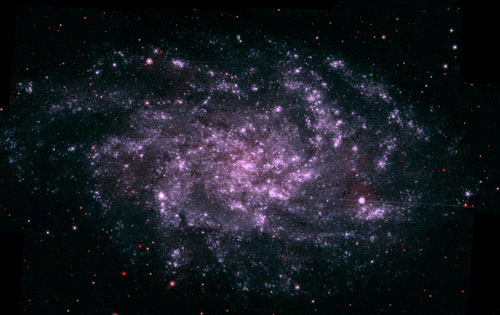Black Holes Key to Spiral Arm Hugs

ST. LOUIS ? As if in a cosmic hug, the spiralarms of some galaxies wrap around themselves more tightly than others. The keyto the bear hug: Galaxies holding heftier black holes at their centers alsohave more tightly wound spiral arms, an astronomer announced today.
The findinggives astronomers a way to weigh so-called supermassive blackholes, which can have masses of millions to billions that of the sun, andare thought to reside at the centers of galaxies.
"Thisis a really easy way to determine the masses of these super-massive black holesat the centers of galaxies that are very far away," said researcher MarcSeigar, an astrophysicist at the University of Arkansas at Little Rock."This gives us a way to measure the size of these black holes out tolarger distances than ever before, up to 8 billion light-years away."
Heannounced the results here at a meeting of the American Astronomical Society(AAS).
Darkbehemoths
A blackhole is the evolutionary endpoint of a star packing at least 10 to 15 times themass of the sun. Once the fat star has burned out, there are no outward forcesto oppose gravity, causing the star to collapse in on itself. The stellarremnant eventually collapses to a point of zero volume and infinite density(called a singularity), and nothing, not even light, can escape its clutches.
Astronomerscan't plop hefty black holes onto a cosmic scale; they can't even see them.Instead, they detect them indirectly and measure a black hole's mass byobserving the orbital speed of nearby stars affected by its tremendousgravity. But this method is limited by the power of current telescopes.
Breaking space news, the latest updates on rocket launches, skywatching events and more!
"Evenwith the Hubble Space Telescope, to be able to resolve the stars at the centerof the galaxy, you can only really look at the nearest 40 or so galaxies,"Seigar said. "That's just maybe 20 million light-years away, somethinglike that."
Tighthugs
The resultscome from a study of 27 spiral galaxies, including the Milky Way and ournearest neighbor the Andromeda Galaxy. Galaxies with the smallest black holesat their centers also showed the loosest "hugs," with angles of up to43 degrees between the arms and the central bulge.
Thetightest embraces came from galaxies boarding with the biggest black holes,such as the Andromeda Galaxy (its central black hole weighs about 180 millionsolar masses), which had just 7 degrees between the spiral arms and the centralbulges.
Seigar andhis colleagues are not sure why spiral arms wrap more tightly around heftiersupermassive black holes and more loosely for the lightweight supermassiveblack holes.
But theythink darkmatter, mysterious matter thought to have played a critical role in the formationof the first galaxies after the Big Bang, could be the driving force.
"Wethink, although this is very speculative, the more concentrated the darkmatter, the larger a black hole you get," Seigar told SPACE.com."And also the more concentrated the dark matter the tighter the spiralarms. So we think it's the dark matter that's driving everything."
(Of thetotal matter in the universe, dark matter makes up 85 to 90 percent, andvisible matter (normal matter, baryonic matter) makes up the rest ? about 10 to15 percent. Of the total mass in the universe, about 74 percent is dark energy,22 percent is dark matter and 4 percent or so is normal matter.)
Thedark-matter connection makes sense, he said: "The more dark matter youhave, the more matter you have, so the more stuff that's there to create firstof all a bulge, and the more mass there is to create a bigger black hole."
Seigar'sfuture research will aim to show whether dark matter is the driving force.
- Video: Slow Birth of a Black Hole
- Video: Black Hole Warping Time & Space
- Vote Now: The Strangest Things in Space

